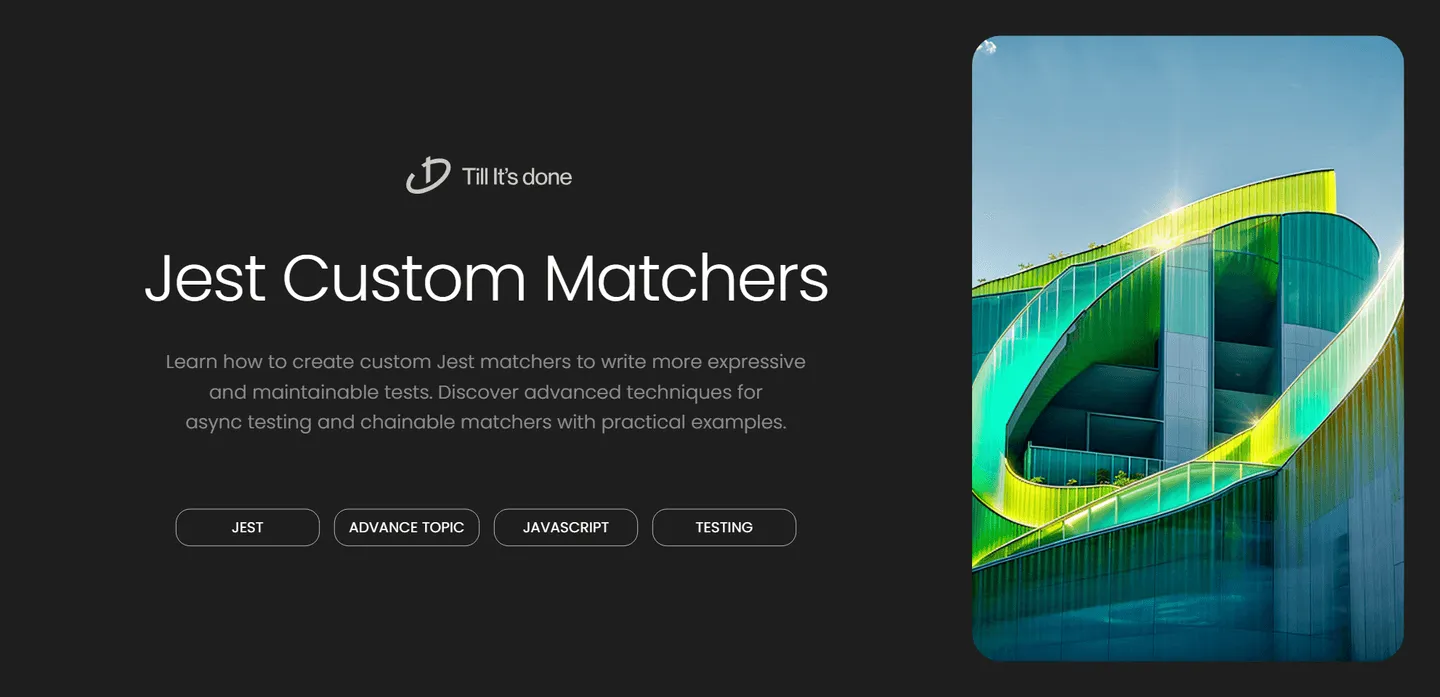- Services
- Case Studies
- Technologies
- NextJs development
- Flutter development
- NodeJs development
- ReactJs development
- About
- Contact
- Tools
- Blogs
- FAQ
Custom Jest Matchers for Better Testing
Discover advanced techniques for async testing and chainable matchers with practical examples.


Custom Jest Matchers for More Expressive Tests
Writing clear and maintainable tests is crucial for any software project. While Jest provides a great set of built-in matchers, sometimes we need more specific assertions that better express our testing intentions. Let’s dive into creating custom Jest matchers that can make our tests more readable and maintainable.
Why Custom Matchers?
Imagine you’re testing a shopping cart functionality. You could write:
expect(cart.items.length).toBe(0);expect(cart.total).toBe(0);But wouldn’t it be nicer to write:
expect(cart).toBeEmpty();This is where custom matchers shine – they help us write more expressive and domain-specific tests.

Creating Your First Custom Matcher
Let’s create a custom matcher that checks if an object has specific properties with certain types:
expect.extend({ toHavePropertyOfType(received, property, expectedType) { const hasProperty = received.hasOwnProperty(property); const propertyType = typeof received[property];
return { pass: hasProperty && propertyType === expectedType, message: () => `Expected object to have property "${property}" of type "${expectedType}", ` + `but got ${hasProperty ? `type "${propertyType}"` : 'no such property'}` }; }});Now we can use it like this:
expect(user).toHavePropertyOfType('age', 'number');expect(product).toHavePropertyOfType('description', 'string');Advanced Matcher Techniques
Let’s explore some advanced techniques for creating more powerful custom matchers.
Async Matchers
Sometimes we need to test asynchronous behavior:
expect.extend({ async toEventuallyHaveValue(received, expectedValue, timeout = 5000) { const start = Date.now();
while (Date.now() - start < timeout) { if (received.value === expectedValue) { return { pass: true, message: () => `Expected value to eventually be ${expectedValue}` }; } await new Promise(resolve => setTimeout(resolve, 100)); }
return { pass: false, message: () => `Expected value to be ${expectedValue} within ${timeout}ms, but it wasn't` }; }});
Chainable Matchers
We can create more flexible assertions by making our matchers chainable:
expect.extend({ toBeWithinRange(received, floor, ceiling) { const pass = received >= floor && received <= ceiling; return { pass, message: () => `Expected ${received} to be within range [${floor}, ${ceiling}]` }; }});
// Usageexpect(price).toBeWithinRange(10, 20);Best Practices
- Keep matchers focused and single-purpose
- Use clear, descriptive names
- Provide detailed error messages
- Document your custom matchers
- Share common matchers across your team
Conclusion
Custom Jest matchers are a powerful tool for creating more expressive and maintainable tests. By encapsulating complex assertions into simple, readable matchers, we can make our test suites easier to understand and maintain.
Remember, the goal is to make your tests as clear as possible – if you find yourself writing the same complex assertions repeatedly, it might be time to create a custom matcher!

 สร้างเว็บไซต์ 1 เว็บ ต้องใช้งบเท่าไหร่? เจาะลึกทุกองค์ประกอบ website development cost อยากสร้างเว็บไซต์แต่ไม่มั่นใจในเรื่องของงบประมาณ อ่านสรุปเจาะลึกตั้งแต่ดีไซน์, ฟังก์ชัน และการดูแล พร้อมตัวอย่างงบจริงจาก Till it’s done ที่แผนชัด งบไม่บานปลายแน่นอน
สร้างเว็บไซต์ 1 เว็บ ต้องใช้งบเท่าไหร่? เจาะลึกทุกองค์ประกอบ website development cost อยากสร้างเว็บไซต์แต่ไม่มั่นใจในเรื่องของงบประมาณ อ่านสรุปเจาะลึกตั้งแต่ดีไซน์, ฟังก์ชัน และการดูแล พร้อมตัวอย่างงบจริงจาก Till it’s done ที่แผนชัด งบไม่บานปลายแน่นอน  Next.js สอน 14 ขั้นตอนเบื้องต้น: สร้างโปรเจกต์แรกใน 30 นาที เริ่มต้นกับ Next.js ใน 14 ขั้นตอนเพียงแค่ 30 นาที พร้อม SSR/SSG และ API Routes ด้วยตัวอย่างโค้ดง่าย ๆ อ่านต่อเพื่อสร้างโปรเจ็กต์แรกได้ทันทีที่นี่
Next.js สอน 14 ขั้นตอนเบื้องต้น: สร้างโปรเจกต์แรกใน 30 นาที เริ่มต้นกับ Next.js ใน 14 ขั้นตอนเพียงแค่ 30 นาที พร้อม SSR/SSG และ API Routes ด้วยตัวอย่างโค้ดง่าย ๆ อ่านต่อเพื่อสร้างโปรเจ็กต์แรกได้ทันทีที่นี่  วิธีสมัคร Apple Developer Account เพื่อนำแอปขึ้น App Store ทีละขั้นตอน อยากปล่อยแอปบน App Store ระดับโลก มาอ่านคู่มือสมัคร Apple Developer Account พร้อมเคล็ดลับ TestFlight และวิธีอัปโหลดที่ง่ายในบทความเดียวนี้ได้เลย
วิธีสมัคร Apple Developer Account เพื่อนำแอปขึ้น App Store ทีละขั้นตอน อยากปล่อยแอปบน App Store ระดับโลก มาอ่านคู่มือสมัคร Apple Developer Account พร้อมเคล็ดลับ TestFlight และวิธีอัปโหลดที่ง่ายในบทความเดียวนี้ได้เลย  TypeScript Interface คืออะไร? อธิบายพร้อมวิธีใช้และข้อแตกต่างจาก Type เรียนรู้วิธีใช้ TypeScript Interface เพื่อสร้างโครงสร้างข้อมูลที่ปลอดภัยและเข้าใจง่าย พร้อมเปรียบเทียบข้อดีข้อแตกต่างกับ Type ที่คุณต้องรู้ ถูกรวมเอาไว้ในบทความนี้แล้ว
TypeScript Interface คืออะไร? อธิบายพร้อมวิธีใช้และข้อแตกต่างจาก Type เรียนรู้วิธีใช้ TypeScript Interface เพื่อสร้างโครงสร้างข้อมูลที่ปลอดภัยและเข้าใจง่าย พร้อมเปรียบเทียบข้อดีข้อแตกต่างกับ Type ที่คุณต้องรู้ ถูกรวมเอาไว้ในบทความนี้แล้ว  Material-UI (MUI) คืออะไร อยากสร้าง UI สวยงามและเป็นมืออาชีพในเวลาอันรวดเร็วใช่ไหม มาทำความรู้จักกับ Material-UI (MUI) ที่ช่วยให้คุณพัฒนาแอปพลิเคชันบน React ได้ง่ายและดูดีในทุกอุปกรณ์
Material-UI (MUI) คืออะไร อยากสร้าง UI สวยงามและเป็นมืออาชีพในเวลาอันรวดเร็วใช่ไหม มาทำความรู้จักกับ Material-UI (MUI) ที่ช่วยให้คุณพัฒนาแอปพลิเคชันบน React ได้ง่ายและดูดีในทุกอุปกรณ์  เปรียบเทียบ 3 วิธีติดตั้ง install node js บน Ubuntu: NVM vs NodeSource vs Official Repo แบบไหนดีที่สุด? เรียนรู้วิธีติดตั้ง Node.js บน Ubuntu ด้วย NVM, NodeSource หรือ Official Repo เลือกวิธีที่เหมาะกับความต้องการของคุณ พร้อมเปรียบเทียบ เพื่อการพัฒนาที่มีประสิทธิภาพ!
เปรียบเทียบ 3 วิธีติดตั้ง install node js บน Ubuntu: NVM vs NodeSource vs Official Repo แบบไหนดีที่สุด? เรียนรู้วิธีติดตั้ง Node.js บน Ubuntu ด้วย NVM, NodeSource หรือ Official Repo เลือกวิธีที่เหมาะกับความต้องการของคุณ พร้อมเปรียบเทียบ เพื่อการพัฒนาที่มีประสิทธิภาพ! พูดคุยกับซีอีโอ
We'll be right here with you every step of the way.
We'll be here, prepared to commence this promising collaboration.
Whether you're curious about features, warranties, or shopping policies, we provide comprehensive answers to assist you.


